Hitler's aircraft carrier
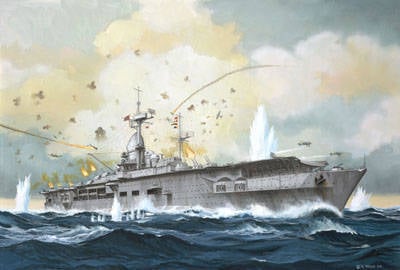
Messages about the start of construction of two ABs in Germany, which first appeared in the naval press in 1936, immediately provoked conflicting assessments among specialists. An analysis of the published characteristics of the first German AB under construction made it possible to conclude that the current German doctrine fleet provides for the possibility of the ship participating in an artillery battle with the enemy, and not only in a situation where artillery is used for self-defense. The armament of the ship with sixteen 150-mm guns was one of the obvious features of the German AB, surpassing the light cruisers of the German fleet in artillery power. In the second half of the 1930s. such an emphasis caused supporters of the American AB concept, which provided maximum attention to its aviation armament and the preservation of only medium-caliber anti-aircraft artillery exclusively for self-defense, a wary surprise. They would be even more surprised to learn that initially the Germans wanted to equip their AB with artillery of a heavy cruiser - eight 203 mm guns. Note that the Americans themselves in the early 1920s. they did exactly the same with their Lexington-class aircraft carriers, but these ships, as you know, were being built in new quality from battlecruisers, so they became an exception to the rule. However, the artillery armament of the German AB, as well as other solid fuel cells of the ship, which were strictly kept secret, were unknown in the West.
The beginning of the AB design work in Germany relates to the 1933 / 1934 winter, when tactical and technical requirements (TTT) were formulated: displacement around 20 kt, full speed of the 33 node, 50-60 aircraft, eight 203-mm guns, powerful anti-aircraft weapons, protection - by standards for light cruisers.
Draft design of the aircraft carrier "Graf Zeppelin"
Sketch design under the direction of the German naval engineer W. Hedeler’s shipbuilding engineer was carried out during 1934. In the course of the work, it was decided to replace heavy 203-mm guns with 150-mm, anti-aircraft artillery in the amount of ten 105 mm guns and large-caliber machine guns, and increase the speed to 35 nodes. The standard displacement of the AB was 23 thousand tons. Apparently, already then the project laid the basic solutions that distinguish it from foreign counterparts. These include the "cruising" armored deck with bevels, the constructive inclusion of the flight deck in ensuring the overall strength of the hull and the lengthy vertical booking of thickness along the hull. The choice of a two-tier hangar scheme was determined by the number of aircraft placed in them.
In the fall of 1935 in the fall with Japanese Akagi and the study of the technical documentation received from the Japanese on the aircraft’s aircraft equipment resulted in the appearance of a third - medium level airplane lift in German AB.
The general architectural layout of the German AB produced the impression of a fairly traditional one: the full flight deck with bow and stern cantilever overhangs, the superstructure displaced to the starboard side - the “island” with the main boilers passing through it, the open layout of the tank and the utah occupying most of the surface of the hull two-tier hangar.
The welded hull of the ship with a length of KVL 250,0 m and a side height of 22,2 m was subdivided by main transverse bulkheads reaching the hangar deck, into 19 waterproof compartments.
A typical protection scheme for German ships was by arranging an armor deck with thickened bevels (40 and 60 mm, respectively) and a narrow armor belt with a maximum thickness of 100 mm located on the KVL in the region of the MKO, was also applied to the AB. The thickness of the upper (flight) deck was 20 mm. Having secured the protection of a mechanical installation with armor, the German designers seemed to have left a high freeboard, behind which was a vulnerable hangar, practically unprotected. However, in part from the penetration of enemy projectiles, the upper hangar should have been protected by 30-mm caliber artillery units located on the side of the half-consonants in armored 150-mm armor casemates, and partially 30 mm-thick longitudinal bulkheads that limited the hangar from the sides.
The most interesting in the project of German AV was actually "aviation"part. Launch of deck vehicles, unlike foreign practice, was supposed to be carried out exclusively with the help of two polyspast-pneumatic catapults located on the bow of the flight deck. K-252 catapults with a sliding truss of the Deutsche Werke factory design provided four starts without recharging air cylinders .
The flight deck, covered with a deck of 50-mm tick bars, had a length of 241,0 m, a width of 30,7 m and communicated with the upper and lower hangars by three electric elevators, which were located on the same axis, somewhat displaced from the center plane to the left side. The bow and middle elevators, which had two octagonal cargo platforms, could simultaneously move aircraft from both hangars, and aft - only from the top. In the fore and aft parts of the flight deck there were lifts ABP, two more elevators were intended for the descent into the hangar (for repair) of aircraft engines and launch carriages. From the cellars to the lower hangar, the ABP was supplied by special lifts, and to the upper ones - only by air lifts.
A feature of the take-off operations was the use of launch carts, on which the aircraft were installed in the hangar and with them were fed to the flight deck. From the elevator platform on rails a trolley with an aircraft with the force of a propeller or with the help of deck spiers was moved to one of the catapults. After the aircraft was launched, the trolley descended on the hangar deck by means of special inclined chain conveyors located in front of the nose section of the flight deck and was transported to the hangar. The elevator was supposed to be used in case of failure of inclined conveyors.
Kiel, January 1941 of the year. Photo taken by a British reconnaissance aircraft.
At the end of the summer of 1939, a small batch of Ju-87C-0 was delivered to the 4 squadron of the 186 th aircraft carrier group, which was formed in December 1938 in Kiel. The aircraft received attachments for launching from a catapult and a landing hook, dropped landing gear for emergency landing on the water and manually folding wing consoles.
To protect airplanes on the deck from side wind, special windshield bombs were designed, raised to an upright position by electric motors by means of a simple screw drive in a few seconds. The landing of the aircraft was to be ensured by four aero-finisher, the cables of which were guided by a system of blocks to the brake winches installed on the intermediate deck. For landing of aircraft in low visibility conditions, the flight deck was equipped with electric curtains, which indicated the dimensions of the runway, flush with the wooden flooring.
The internal structure of the hangar, the design of the petrol and oil systems, the fire fighting equipment of the German ship differed in a number of noteworthy original technical solutions, among which are the high-speed fireproof curtains, the starting carriage transport system and aircraft engines, fuel and oil filling columns in the hangar.
The total capacity of aviation gas tanks, located in two storages in the forward part of the ship hull, exceeded 330 thousand liters. Aircraft refueling with fuel and oil (as well as the suspension of ammunition) should have been carried out in hangars equipped with filling stations. The same posts were envisaged on the flight deck.
The ship's GEM, in accordance with the applicable standards of the German fleet, was chosen without special hesitation by a steam turbine, with increased steam parameters. Required for the development of the full stroke 200 thousand hp distributed into four shafts, which were supposed to drive the GTZA with a full design capacity of 50 thousand hp. Each unit was supplied with steam (75 atm., 450 degrees. C) four La Mont boilers with a capacity of 50 t / h. The supply of boiler fuel in the 6500 t was sufficient to provide a cruising range of six thousand miles with an economic course. An interesting technical feature of the German AB was the use of two Voit-Schnaider units — wing-type propulders — to increase the controllability of a ship with a large sail at low speeds.
The order for AB "A" standard displacement 24114 t was issued to Deutsche Werke Kiel 16 in November 1935. The bookmark AB under the 252 serial number on the stocks 1 took place on December 28 1936. Two years later, 8 in December 1938, a solemn ceremony took place the launching of the ship into the water attended by the top leaders of the Reich - Hitler and Goering. On that day, AB was named - he christened it in honor of his famous father, Countess Hella von Brandenstein-Zeppelin (Hella von Brandenstein-Zeppelin).
One of the main difficulties on the path of the first German AB was the creation of deck aircraft — Reich Aviation Minister G. Gering, seeing in Adam Reder’s insistent desire to get deck aircraft (and “at the same time” - and subjugate naval aviation to the fleet) did not manifest the threat of its monopoly there is no interest. His winged expression was the famous: "Everything that flies is mine!" However, in 1938-1939's. passed flight tests fighter-biplane "Arado-197", which was a development of "Arado-68". The “Me-109T” was finally approved for the role of a deck fighter, and the “Junkers-87C” was planned as a deck attack aircraft. Five Junkers-87С machines equipped with folding planes were manufactured and tested at the Luftwaffe Flight Test Institute in Travemünde. The Germans planned to use the Fieseler 167 and Arado 195, built in prototypes, as multipurpose aircraft (reconnaissance aircraft and light torpedo bombers).
German soldiers posing in front of the colossus. Kiel, September 1941 of the year
The crew of the Aviation Group AB, which changed during the construction process for March on 1941, was supposed to include twenty multi-purpose Fi 167 planes, ten Me 109T (Bf 109Т) fighters and thirteen Ju 87C dive bombers. The air group was located as follows: 18 aircraft - in the lower hangar, the remaining 25 - in the top.
Launched "Graf Zeppelin" at the beginning of the war has already reached 85% readiness. The formation of the crew and air group V / 41.
At the end of April, 1940, at the suggestion of the Commander-in-Chief of the Navy, the work on the construction of the AV is stopped, 150-mm guns are dismantled and sent to Norway - to strengthen the coastal defense. 6 July 1940. The tugs transferred the “Graf Zeppelin” to Gotenhafen, where it was used as a floating warehouse. Before the attack on the USSR, fearing possible raids by Soviet aviation, the caring owners towed it to Stettin - the Graf Zeppelin ш 21 of June was moored there. After being convinced that their fears were unfounded, in November the Germans transferred the ship back to Gotenhafen, where it stood until spring 1942.
16 April 1942 Fuhrer decides to resume completion of the "Graf Zeppelin".
Due to the danger of the air raids, the transfer of the ship to Kiel was postponed, during which time three twin 37-mm and two quad 40-mm anti-aircraft guns, anti-aircraft searchlights, were installed on it. On November 30 alone, 1942 three tugs brought the Graf Zeppelin into the sea, and on December 5 escorted three minesweepers and six Graf Zeppelin escort boats safely to Kiel, where he was immediately put into the 40000-ton floating dock and began work. However, on January 30, 1943 was followed by a new order from Hitler - to stop completing the construction ... Admiral Raeder commented on this event, calling the consequences of the Fuhrer’s decision "the cheapest in stories the victory of England at sea. "21 April 1943." Graf Zeppelin "was transferred to Stettin, where he stood until the end of the war.
By April 1945, the state of AV was characterized by the following: there was no artillery equipment on it, the installation of instruments and the equipment of fire control posts was not completed; the electrical equipment is only partially assembled, as well as special aviation technical devices.
At the time of the attack on the city of Soviet troops "Graf Zeppelin" was in the channel of the river Monder Oder. In 18.00 24 on April 1945, the senior naval commander of Stettin, captain Zurzee V. Kahler (W. Kahler), gave radio orders to a special team stationed on AV. The explosions of the charges laid very intelligently led to the complete uselessness of the use and restoration of the main turbines, electric generators, aircraft lifters. By the time Soviet troops entered the city, small water holes penetrated into the internal compartments of the AB hull through small holes, cracks and leaks in the outer skin, and the ship was therefore in a submerged state.
The aircraft carrier Graf Zeppelin (Graf Zeppelin) in Stettin, June 1945
In the summer, the ship was raised by forces of the Red Banner Baltic Fleet Emergency Rescue Service; on August X, the unfinished and disfigured German Air Force was recruited by the German Navy as a combat trophy.
Shortly after the signing of the act of capitulation of Germany in the Second World War, the Potsdam Conference of the three victor Powers was held. Among the decisions of this conference was this: "Suitable for use surface ships of the German fleet, including ships that can be brought to expiration within the prescribed time, along with thirty submarines will be equally divided between the three Powers. The rest of the German fleet will be destroyed." 23 January 1946, the newspaper Pravda published an Anglo-Soviet-American communique, announcing the appointment of a tripartite naval commission.
The USSR got as a result of the drawing “Graf Zeppelin” got into the group “C” - flooded, damaged or unfinished ships, which had to be repaired by means of German shipyards for more than half a year to be alerted.
The tripartite commission developed recommendations, in accordance with which all warships of the “C” group were to be destroyed in a timely manner by flooding at great depth or disassembling into metal.
In 1947, the government issued Resolution No. 601 "On the destruction of former German ships of category" C "in 1947. At the suggestion of the new command of the USSR Navy, it was decided to use these ships for conducting experiments on the combat survivability (the same was done with trophy ships Allies, the most valuable practical experience was gained by the Americans as a result of the bombing of the German battleship “Ostfriesland” even after the end of the First World War).
After raising. Stettin, 1947 year
The “Graf Zeppelin” liquidation was handed over to the TsNIIVK with the maximum military-scientific and practical effect. For this purpose, a special commission was created under the chairmanship of Vice-Admiral Yu.F. dynamic "(actual shooting and bombing) options. It was assumed that the AB would first undermine the pre-laid bombs and artillery shells of various calibers, then it would be bombed from airplanes, shot from the guns of the main caliber of cruisers and, finally, complete the work of "dashing" torpedo attacks of surface ships. It was also planned to undermine mines at various depths and distances. In the intervals between the variants of this scenario, groups of military scientists were to measure, calculate, and test elements of the ship with minimal actions to restore its survivability (for example, starting pumps for pumping water).
The implementation of the test program was assigned to the 4 of the Navy.
By the time this decision was made, Graf Zeppelin was far from being in the best condition, even from unfinished construction. By 17 August 1945, the ship was surveyed in the naval base Stettin by the 77 squadron of the ACC Red Banner Baltic Fleet. "Count Zeppelin" lay (or rather, "stood") on the ground without trim with a slight roll on the starboard. All turbines, auxiliary boilers and electric generators of the ship were blown up by the Germans, and the watertight bulkheads were destroyed at the explosion sites. There were underwater holes with 0,8 dimensions on 0,3 m and a crack of about 0,3 m length. The propellers were removed from the shafts and placed on the flight deck (to reduce the electrochemical corrosion of the hull). The aircraft lifters were also blown up, and there was a large dent in the flight deck area with a 0,2 m deflection. Other, less extensive dents from projectiles hit the flight deck flooring.
The rise of "Graf Zeppelin" was carried out by simply pumping out water with motor-pumps with preliminary sealing of the underwater hole and the crack. Surface holes in the hull and faulty windows illuminated, however, the damaged watertightness of the decks was not possible to be restored due to the large amount of work and lack of time.
After that, the "Count Zeppelin" was towed to Swinemünde. When the ship arrived at a given square on the night of 15 on 16 August, it turned out that the station anchor because of the break of the anchor chain (which turned out to be a defective link) would not succeed, and the Admiralty light anchor (small stop anchor) would only limit AB drift to an insignificant degree. This circumstance, as we shall see, had a decisive influence on the entire test program.
On the morning of August 16, tests began on the surface effects of ammunition. First, the FAB-1000 (in the chimney), three FAB-100 and two 180-mm artillery shells under the flight deck were simultaneously undermined (FAB is a high-explosive aerial bomb with a corresponding weight-caliber index in kg). During the second blast, another FAB-1000 was blown up on the flight deck. The third series of simultaneous explosions was the simultaneous detonation of a FAB-250 and two 180-mm projectiles.
After the first series of explosions, an aerial bombardment of AV was carried out by aircraft. For this task, the 39 crews of the 12 Guards Aviation Regiment, the 8 th Torpedo Division and the 25 of the Pe-2 airplanes — all of the operational aircraft of the regiment — were assigned. Two nines of planes bombed at the signal of the lead in the link, and part of the Pe-2 attacked the target individually. The strikes were provided by two Catalina-type planes, one of which, while above the target, brought a strike force at it, and the second worked in the search and rescue variant. In addition, the shock groups were also controlled from Volynets, and on the deck of the “victim” a white 20 cross was painted on 20 m with a width of five meters.
The first attacking group struck from a height of 2070 m and dropped 28 aerial bombs, the second - approximately the same height, dropped 36, and the third (individual bombing) “unloaded” 24 with bombs. Three aircraft were forced to drop bombs at sea in an emergency. The result of the bombing of the almost immobile, defenseless and not at all small ship turned out to be “impressive”: out of a hundred bombs only six hit the target, and only five hits were found in the deck. The pilots insisted on eleven, believing that part of the bombs had fallen into places already destroyed by previous explosions. One way or another, the bombardment of the AB did not give anything in terms of survivability: the P-50 bombs turned out to be too thin and did not cause significant damage, except for dents in the 5-10 depth deck. However, one of the bombs made a hole in a bule with a diameter around 1 m. For combat training, "Stalin's falcons" attack "Graf Zeppelin" were too polygon and, apparently, a little instructive: air defense, of course, was not carried out, the guidance aircraft freely "walking around" the target, the height of the bombing corresponded to the area of Foot anti-aircraft fire.
At this point, the “static” surface test program was completed, preparations for conducting tests under the influence of underwater weapons. However, 17 August began a gradual deterioration of the weather - increasing excitement to three points (wind - 5-6 points) - and AB began to drift into the shallow water area. There was a real threat that it could not be flooded at a decent depth (at the beginning of the test, such was 113 m, and at the end of the first stage - already 82 m). Vice-Admiral Yu.F.Rall made an independent decision to stop the tests and quickly finish off the AV with torpedoes of surface ships. Therefore, torpedo boats (such as “Elko”) TK-248, TK-425 and TK-503, as well as the destroyers Glorious, Strict and Slender were called from Baltiysk. The first to AB profit boats. The TK-248 attack was unsuccessful - the torpedo, without exploding, passed under the keel of the AB. After 15 minutes TK-503 hit a torpedo in the starboard. The explosion destroyed the structure of the boule, but the armor belt located behind it was intact. An hour later, the destroyers approached, the “Glorious” torpedo shot back into the starboard again. "Count Zeppelin" began to slowly fall on the starboard side, after a quarter of an hour the roll reached 25 hail. At the same time, the trim on the nose increased. Eight minutes later (after 23 minutes after the explosion of the second torpedo) “Graf Zeppelin” with a roll of 90 hail. and trim on the nose 25 hail. disappeared from the sea.
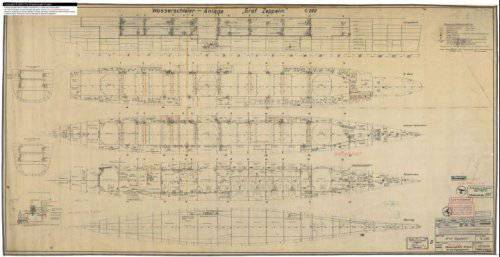
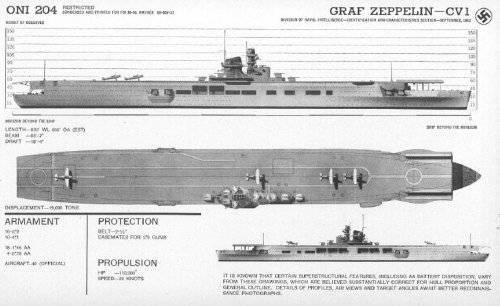

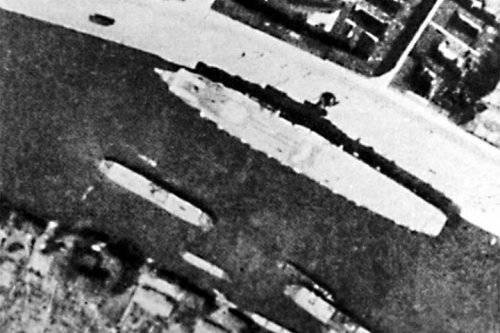
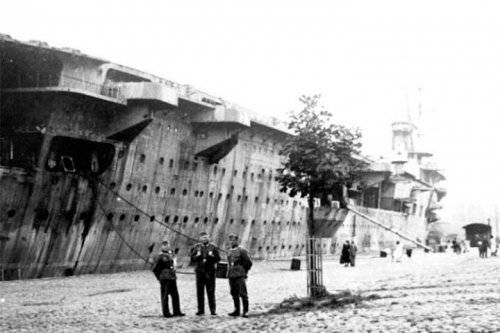
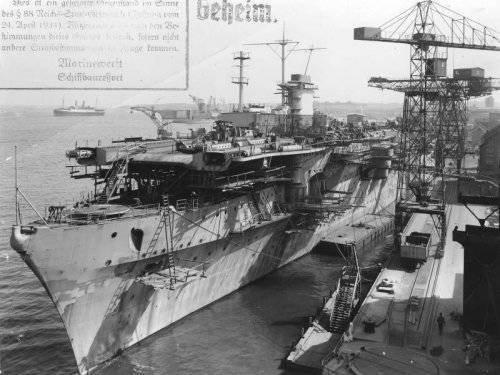
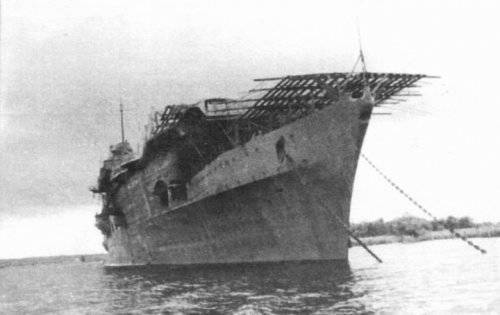
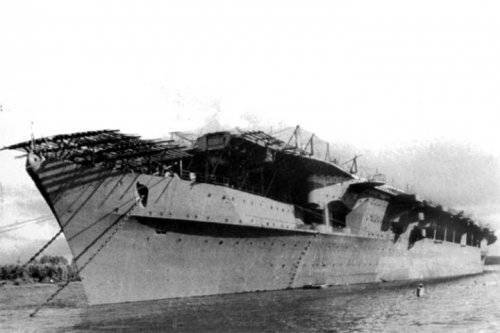
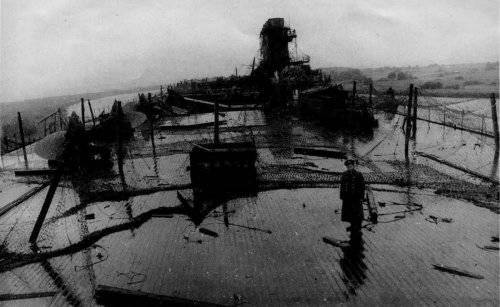
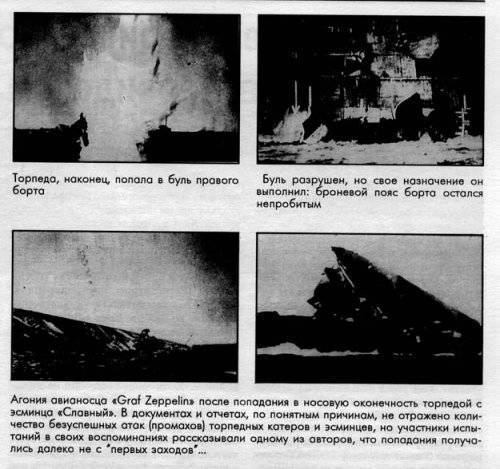
Information